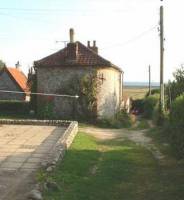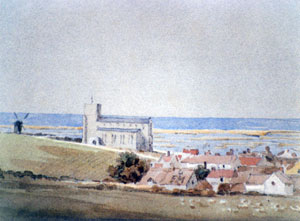a Deed of Assignment:-
Norfolk Chronicle,
20 September 1834
Notice to Debtors and Creditors of LEEDS RICHARDSON of Salthouse, Miller Deed
of Assignment for benefit of Creditors.
Mr Stokes, Solicitor, Fakenham. 18 September 1834.
His stock in trade,
furniture etc. were then sold by auction.
Norfolk Chronicle, 27 September 1834
Sale by WM ANSELL on Tuesday 30 September 1834
All the STOCK in TRADE, Household Furniture etc. of Mr Leeds Richardson of
Salthouse, Miller,
(Under a Deed of Assignment for the benefit of his Creditors at 11 o'cl;ock.
Comprising about 8 coombs of wheat, seven and a half sacks of flour, quantity
of meal and offal, sacks and sack barrows, bags, beams, scales and weights
with all the mill fixtures belonging to the tenant such as jigger, jumper,
straps, wedges, roller, brushes, sail cloths, lever, ladders, flour and meal
bins and sundry other property in the mill. Also two flour carts and
harness, capital harness mare, saddle and bridle, sow and 8 pigs, hay
engine, iron crow, water cart, wheel-barrow, grindstone, about half
a rood of potatoes, four pig trough small quantity of barley, small piece
of hops, bushel and other measure etc.
The Household furniture . . .
The property was then to be let again:-
Norfolk Chronicle, 11 October 1834
To Millers
To be Let with Immediate Possession
A Small TOWER WINDMILL situate at Salthouse near the Market Town of
Holt, driving two pair of French Stones, with comfortable Dwelling
house, Garden and about one acre of Land.
Enquire of Mr Ransom, Solicitor, Holt; if by letter, free of postage.
It was also offered to be sold or let in November. George Larner Neave,
1836 is given as occupier in the 1839 Tithe Award with Parlett Starling
as owner.
Evidently in the same ownership as the water paper mills at Upper Sheringham,
the mill was again for sale or to be let in January 1840:-
Norfolk Chronicle, 11 January 1840
To be Sold or Let
All those PAPER MILLS at Sheringham . . .
Also a small TOWER CORN MILL situate at Salthouse in the said county,
driving two pair of Stones with Going Geers complete.
Apply to Mr Ransom, Solicitors, Holt.
3 Evidence from the Thirtle
watercolour
Harry Apling told me that there is a picture of the mill, owned by
someone he knew who lived in Loughton, Essex. It so happened that
I knew a person of the same name, a fellow veterinary
surgeon. I wrote to him in 1984 and this is his reply:
‘I have a small water colour painting attributed to Thirtle of the
Norwich School of painters dated 1831 that shows a windmill apparently
a short distance away from the west end of the churchyard. My great grandfather
Philip Keymer (1815-1887) was a millwright in Salthouse in 1841 and I suspect
this may have been where he worked or possibly at Holt. The Keymer family
lived at Salthouse from 1782 to 1886 and one of their properties is still
called "Keymer Cottage". It is situated on the Coast Road
between the path to the church and the road junction.’
We finally arranged a meeting in 2001. He brought the water colour and
the final piece of the jigsaw was put in place.
Conclusions
There is conclusive historical evidence, both from early maps and from
sale notices in the contemporary press that there was a mill at the
top of Grout’s Lane, dating from the early part of the 19th Century.
This has been confirmed by the exposure of brick foundations by Mr
K. Brown in the 1950s and our own excavations. No doubt hauling wagons
or tumbrils loaded with sacks of corn up the hill would have presented
a difficulty.  An
additional trace horse would have been used and the severe right-hand
turn at the top of Grout’s Lane was facilitated
by the corner of ‘Hill
Top’ being built in a rounded fashion which can still be seen
(the white line in the picture is an arrow pointing to the rounded
corner).
An
additional trace horse would have been used and the severe right-hand
turn at the top of Grout’s Lane was facilitated
by the corner of ‘Hill
Top’ being built in a rounded fashion which can still be seen
(the white line in the picture is an arrow pointing to the rounded
corner).
There is yet another unanswered question. Was the mill a post mill,
smock mill or tower mill? Mrs Radley told us it was a post mill; Bryant’s
map of 1826, Harry Apling and evidence from the Thirtle painting, suggest
it was a smock mill; all the ‘for sale’ notices describe
it as a tower mill. The last named description fits in with the finding
of substantial brick foundations. However, it is still possible that
either a post or a smock mill preceded the tower mill.

photo © Dr Keymer 2002
you can see this information again and thousands of other mills too.
_small.jpg)
photo © Val Fiddian 2002
© Val Fiddian 2005 
Finally the Salthouse tithe map of 1838 shows the mill unmistakably.